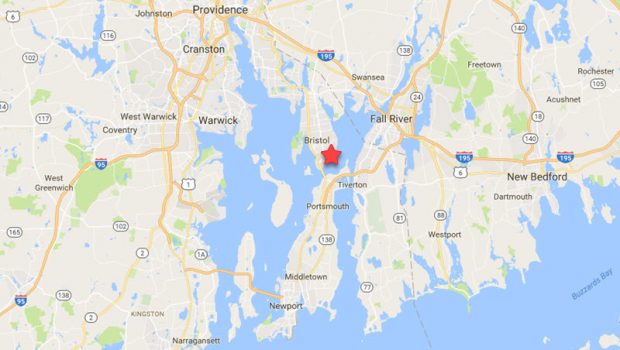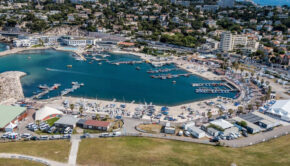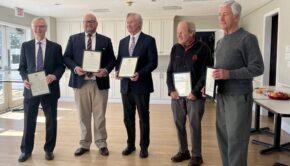US Sailing: On The Move
Published on October 11th, 2017
As the national governing body for the sport of sailing, these are exciting times for US Sailing. Scuttlebutt editor Craig Leweck took a tour of the organization’s new facility in Bristol, RI and met up with Chief Executive Officer Jack Gierhart for an update.
Let’s start with some history of the offices.
Initially, the office was at 44th Street at the New York Yacht Club in Manhattan. The next stop was Goat Island, which early on was just a two or three person office. Soon enough growth required the move up to Portsmouth to the Ted Hood building which has been our location for the past 20 years.
There we had flexibility of expanding as we grew further, and we were lucky to have Ted Hood and his son as landlords working with us as we increased the space.
The problem was the layout. It was a bunch of really small offices and hallways, and we had four or five different areas in the building. Collaboration was difficult as there was not one place in the office where you could look and see more than two people. It was fragmented and not in synch with how the organization was advancing.
If you look at the structure of the staff at US Sailing, it had evolved around how best to support the volunteer committees which is crucial, especially in an era when the volunteers were really doing a lot of the heavy lifting. And 20, 30 years ago, that volunteer group ran the organization both strategically and operationally; it was responsible for getting stuff done. The staff was more administrative.
But over the last decade or two, we’ve expanded a professional staff to best leverage the limited time of volunteers, working to remove the tedious tasks and enable them to focus on applying their expertise and be more productive.
With an office structure that had 9 or 10 departments which focused on their committees, there’s a lot of stovepipes. So four or five years ago, we started to say, “We’ve got to break this down.” Then in 2016, we developed a plan to optimize the organizational structure and really look outward at who the customers were – the local sailing organizations.
In addition to the Olympic department, we created a youth department, an adult department, and a competitive services department – all customer facing – and then supporting those departments we expanded – the training department to include race administration, Safety at Sea, as well as the hands-on on-the-water training into one department to take advantage of best practices in building first class education programs.
We did the same with a fulfillment and member services department because, again, those nine departments had been doing soup to nuts on their own. We focused on consolidating best practices from the different areas and developing standard, efficient and sustainable processes and procedures; we’ve made a big push to digitize our office, scanning over 400,000 pages of records, including rating certificates from the 70’s and 80’s.
So we now have this new, 21st century organizational structure, but we were living in a 20th-century building and working with pickaxes and rakes to do our work.
Luckily, about four years ago, when Roger Williams University started their campaign to build their new Sailing Center, they brought us in to learn how US Sailing could benefit from this. They invited us to be involved and we started to talk about how we could run some of our seminars there and start to do some research and development. I said during one of these discussions, sort of off-handedly, “What we really are looking for is a new office space.”
We could see a light go on with the University. Apparently, there was a building in the middle of the campus that was owned by the state. They’d been trying off and on to acquire it and nothing had ever fallen in place. But our interest in becoming a partner with the university sparked a new flame.
It took them three years to negotiate with the state, and when they succeeded, we worked together to create a new office design to mimic and support this new organizational structure we have, and that could best serve our strategy going forward. The timing was perfect: we were finalizing our organizational structure as the architects were working on the building design. And now we are done, we are moved in, and the university is so excited to have us here.
We’re going to have access to the new phenomenal Sailing Center they’ve built. We’ve held several board meetings on the campus already. Roger Williams has state-of-the-art facilities. They’ve got conference space and athletic facilities. We envision using the pool where we can work with organizations to run really high-quality Safety at Sea seminars and other programs.
This is really a tremendous opportunity to have access to the assets and infrastructure of the university and access to interns. John Pierce, the head of our youth department, is working closely with the school’s sailing team coach, Amanda Callahan, on youth development strategies and how the Olympic program can benefit from the facility. It’s a very exciting time for US Sailing to have all these resources to serve the sport.
So rather than US Sailing relying heavily on clubs and organizations to host events, you foresee US Sailing now able to provide the facility to serve the sport?
We certainly do not want to take away from what the clubs and the community programs and the other organizations are doing, but there’s only so much that they can do. As we now have the assets and the infrastructure of a university at our fingertips, I see how this just opens up the potential. I look at it as we’re expanding the pie. When we talk about doing safety research, we can do it right here. I know a lot of times there are clubs that like to host events, but getting the necessary volunteers and equipment can make it pretty complicated and burdensome. I see now how we can fill gaps. At the university, we have a platform for doing some really 21st-century training and education.
Sounds like you are now in a period of discovery of what’s possible.
Absolutely. These are exciting times. We now have access to interns and the opportunity to partner their marine sciences department with our stem education modules. I can see working with the university’s engineering department to get some of those students involved in some of the Olympic sailing team projects. I’m just shooting from the hip right now, and can only imagine what the suggestion box will get filled with. I keep saying it, but our new location now has an incredible amount of opportunity.
Having access to a fully-fitted Sailing Center is pretty awesome.
And the university is eager to activate the Sailing Center in the summer as it’s not very busy. We think between the university and US Sailing, we can deliver a lot more activity. They have all sorts of other sports that come to the university in the summer such as basketball, volleyball, and baseball, and they’ve got the dorm facilities and food and beverage facilities, but they’re not using the Sailing Center. So it’s a natural progression for us to tap in to this opportunity.
Any ideas how?
I can totally see us using the venue for the US Sailing championships and to expand our adult, youth, and Olympic clinic programs. John Pearce is working on a youth development model that’s seeking to learn from what other sports are doing. I think everything is here that you need.
Pretty nice to be based in a region where sailing is so front and center.
We’ve got great partners, and with the sailing community here in Newport and in Bristol, with all the museums, yacht clubs, and public access. I think we have an opportunity to help bring all these entities even closer together. I see one of the biggest challenges we have as a sport is the fragmentation, with everybody sort of doing their own thing. We need to create an environment where there’s opportunities to come together and work more in concert. I look at our move to Roger Williams and those facilities in that location to help do that.
Sounds like you have a pretty ideal partner with Roger Williams University.
In the four years we’ve been working with them, and specifically the year that we’ve been working on this building, it has been a true partnership. There’s never been a contentious discussion over, “Well, we can’t do that.” They look forward to the challenge, and they’ve got this positive approach to make things happen as opposed to creating obstacles. The culture at the university is a can-do attitude.
It’s a relatively new university, founded in 1956, and they’re growing. And sailing is the pinnacle sport for the university. Everybody embraces it. When you go to other schools, their big sport might be football or basketball. But at Roger Williams, it’s sailing, so they’re going to do whatever they can to help us advance the sport.
I think they see themselves as really not only advancing their programs, and making their sailing team is strong, but they really want to help the sport. So we are fully embracing how this culture is going to be really refreshing and helpful to sailing.










 We’ll keep your information safe.
We’ll keep your information safe.